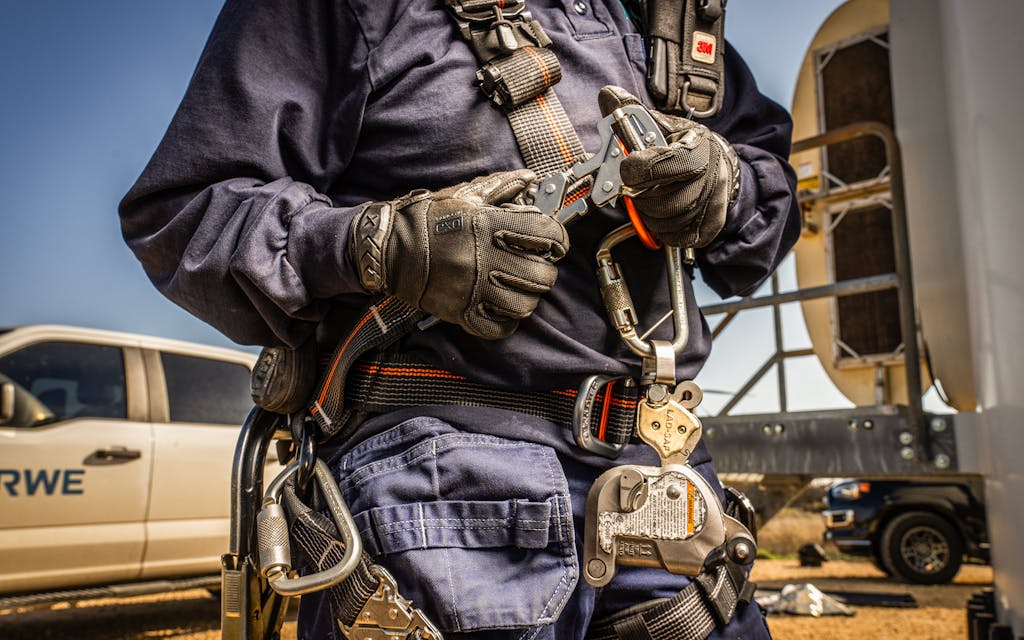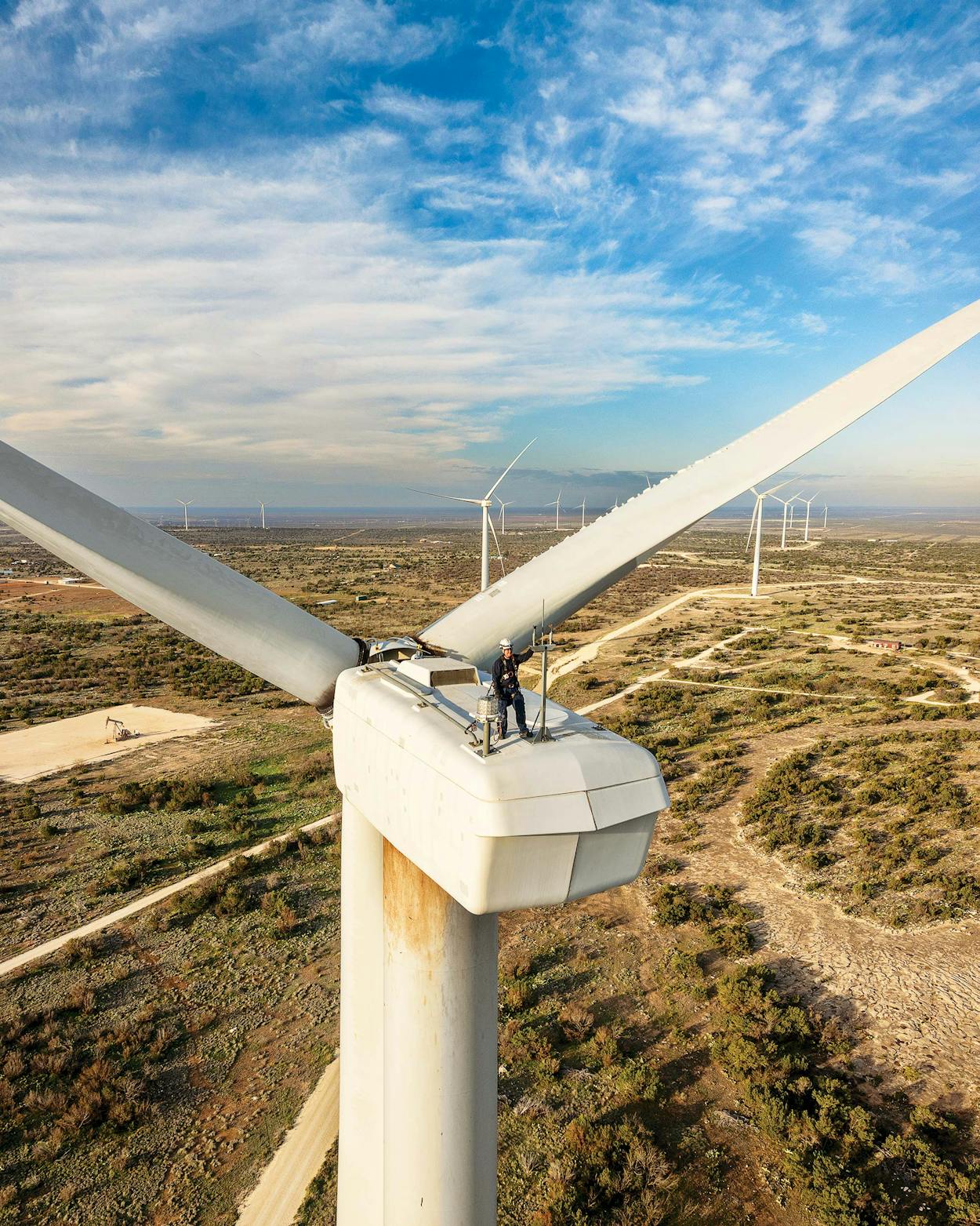Caroline Esquivel, who is 39, maintains wind turbines for RWE, a renewable energy firm that operates 26 wind farms across Texas.
My day starts at 4 a.m. I have an hour-long commute from Odessa to Big Spring, so I leave my house at 4:40 to get to work around 6. If I leave ten minutes late, I hit traffic. I don’t drink coffee or energy drinks, and everyone’s like, “How do you survive?” I don’t know—my parents taught me to work hard at whatever I do, so I just go. In the mornings I hardly even listen to music. Sometimes I’ll pick up a coworker who needs a ride, but mostly I’m just driving.
When I get to the site, I meet up with my partner, and we wait for the itinerary to tell us where we’re supposed to go. Which towers’ electricity went down overnight, or which towers need maintenance? I work at Panther Creek Wind Farm. We have 305 towers, but I’m assigned to work on only 133 of them. We do maintenance on each tower every six months, kind of like an oil change. You grease blades, you change filters, you torque bolts. Everything that holds the tower together—that’s what we’re doing.
The climb is the hardest part. The towers are about three hundred feet tall, and it takes four or five minutes to reach the top. The ladder is inside the turbine. First we send our gear up with a chain and a hoist, and then we climb. We have a thing called Climb Assist that alleviates some of the weight. The newer towers have elevators, but I haven’t seen one yet. Trust me, there are days when I’m like, “Oh my goodness, why am I here?” When I first started, nine years ago, my legs were sore. Muscles on my back I didn’t even know I had were sore.


There are about 27 guys out here, and I’m the only woman. We’ve had four others, but they come and go. My coworkers are like, “If she can do it, then y’all can do it, and quit complaining.”
Once I get up there, I wait for my partner. We get assigned a partner once a year, and you stick with that person. My only request is that they’re taller than me, because there’s a section where you have to grab a ladder—I’m about five two, and I can only reach it by standing on something, so usually I have my partner grab it. The guy I’m with now, he does not talk for nothing. He’s real quiet. But over time, you grow that relationship, and you get in a good flow.
You’ve gotta know your people. One time, one of the loudest guys was so quiet. I was like, “Are you good?” He said his grandma was in the hospital. He was there physically, but mentally he wasn’t. He didn’t want to go home, but after I said something, they sent him home that day. It’s good to notice things—I don’t know if many men would have noticed that.
Before I worked in wind, I was a manager for a norteño band called La Furia del Bravo. We went on the road, and it was fun, but there were times I slept in the van and showered at truck stops. Trying to book shows was like selling a pair of shoes that nobody wanted to buy. Before that I got an automotive degree and used it maybe a year, and I worked at a cleaners in Austin for six or seven years. After a while managing the band, I was like, I better start a career, and I went to technical school for wind.
You need a lot of patience in this job. The guys can do more physically, but I think I’m better at the mental side. You might have to figure out why a breaker was tripped and start reading schematics, asking for help, then calling for a part if you didn’t take it with you. The frustration can get you. Music is a must. I bring a Bluetooth speaker and put on some hip-hop, some Spanish, some country. When something isn’t working, I’m like, “Let’s put some music on and try this again.” When you figure it out, it’s a cool feeling.
Being a woman in this field, you have to have tough skin. The guys are always messing around, but everybody sees me as their little sister, and they kind of watch out for me. It’s hard to find steel-toed boots in my size—five and a half. I can’t just go to Academy like everybody else. There’s a workwear store in El Paso, where my family lives, where I always get them. And I didn’t realize until I started working that there are no restrooms out here. So I try to go right before we get to the site. There are a bunch of bushes and mesquite trees, and you kinda become one with nature.

When the wind speeds are really high and the tower is shaking, it feels like walking on a boat. You never know what kind of weather you’re going to encounter. The only time we stop work is when there’s lightning. If it’s windy, hot, or raining, we still work. We get flying ants—and they bite too—and bees. Some people say they’ve seen snakes go up through the cable. The only thing I don’t like is the cold. If my hands and feet are cold, don’t talk to me! I’ve met guys who have a fear of heights, and I’m like, “What are you doing out here?” But I like to look down—it’s one of the best parts.
Before going down for the day, we always do a walk-around inside the top of the turbine to make sure we have all our things. Nobody wants to climb back up for a tool that they forgot. You tend not to take personal things with you, like your wallet, because of the risk of forgetting or dropping it. We do take our phones with us by harnessing them to ourselves. There was a guy who forgot his keys one time on top of the tower—that’s a bad day.
You can’t beat the scenery. The view changes depending on the weather. On a foggy day, it feels like you’re on a cloud, because you can’t see anything underneath. Sometimes there are birds flying above us. I’ll send photos to my family, and they’re like, “Oh my god, be careful.” There are sheep and cows, and they look like tiny little salts-and-peppers below us. When I first started, I would hear a siren, and I didn’t know what it was. It was the people feeding the animals. They herd them with a siren. I’d stick my head down and see all the little salts-and-peppers running to get fed. You can sit up there and just meditate.
Note: Texas Monthly senior editor Rose Cahalan’s husband is a wind-energy analyst for RWE.
This article originally appeared in the May 2024 issue of Texas Monthly with the headline “Caroline Esquivel, Wind Turbine Technician.” Subscribe today.
- More About:
- Working Life
- Wind Power
- Big Spring









